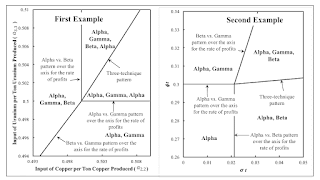Figure 1: Three Patterns Across The r Axis And One Three-Technique Pattern This post continues the approach in this post. I consider the same two examples. In both examples, three processes are known for producing the numeraire, called "corn". In the example for the left panel, corn is a non-basic commodity, and a different basic commodity is used in all three techniques. In the example for the right panel, all three corn-producing processes require inputs of labor power, corn, and labor (in different proportions), and managers firms know of a single process for producing iron. Both commodities are basic in this second example. The examples are also parametrized differently. These examples are all part of my investigation of how reswitching, capital-reversing, a reverse substitution of
Topics:
Robert Vienneau considers the following as important: Example in Mathematical Economics, Sraffa Effects
This could be interesting, too:
Robert Vienneau writes Austrian Capital Theory And Triple-Switching In The Corn-Tractor Model
Robert Vienneau writes Double Fluke Cases For Triple-Switching In The Corn-Tractor Model
Robert Vienneau writes The Emergence of Triple Switching and the Rarity of Reswitching Explained
Robert Vienneau writes Recap For A Triple -Switching Example
| Figure 1: Three Patterns Across The r Axis And One Three-Technique Pattern |
This post continues the approach in this post. I consider the same two examples. In both examples, three processes are known for producing the numeraire, called "corn". In the example for the left panel, corn is a non-basic commodity, and a different basic commodity is used in all three techniques. In the example for the right panel, all three corn-producing processes require inputs of labor power, corn, and labor (in different proportions), and managers firms know of a single process for producing iron. Both commodities are basic in this second example. The examples are also parametrized differently.
These examples are all part of my investigation of how reswitching, capital-reversing, a reverse substitution of labor, process recurrence, and so on can emerge and disappear with perturbations of parameters in post Sraffian models of prices of production.
I call a case when a switch point exists on the wage frontier at a wage of zero a "pattern of switch points over the axis for the rate of profits". When three wage curves intersect on the frontier at a single switch point, I say this is a "three-technique pattern" of switch points.
I claim that the two panels in the figure at the top of this post are the same, at some level of abstaction. Suppose that in the left panel, replace every instance of "Alpha, Gamma" is replaced by S1. Suppose every instance of "Beta" is replaced with "Gamma" and every remaining instance of "Alpha" with "Beta". Let every instance of S1 be replaced with "Alpha". Rotate clockwise somewhat and stretch and otherwise distort the regions.
In both panels, one will then have a region labeled with "Alpha", alone. And it will be bounded by two loci, each designating parameters for a pattern of switch points over the axis for the rate of profits. The region diagonally opposite is then bounded by a locus for a third pattern of switch points over the axis for the rate of profits and a locus for a three-technique pattern.
In other words, loci for three patterns of switch points terminate at a point that is also the terminus for a locus for a three-technique pattern of switch points. For the example illustrated by the left panel, a second switch point exists on the wage frontier for a smaller rate of profits than the one concerned in the patterns of switch points.
So here is another generic structure in the parameter spaces relating to the analysis of the choice of technique.
 Heterodox
Heterodox

